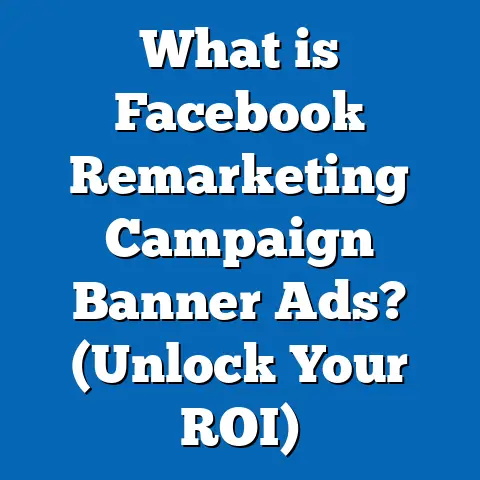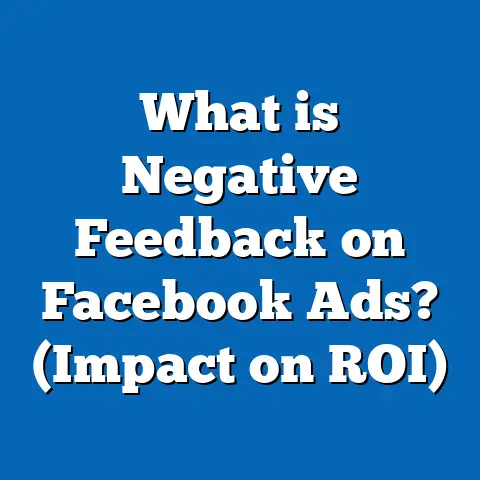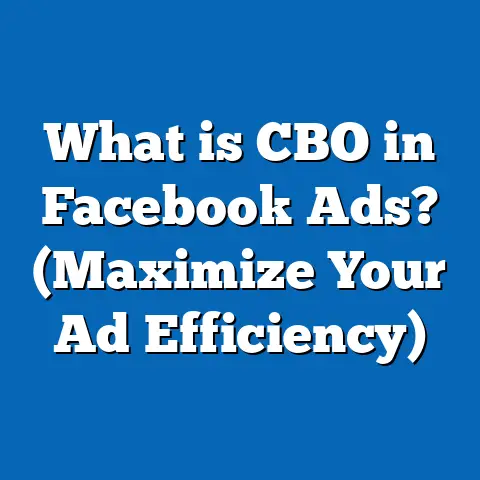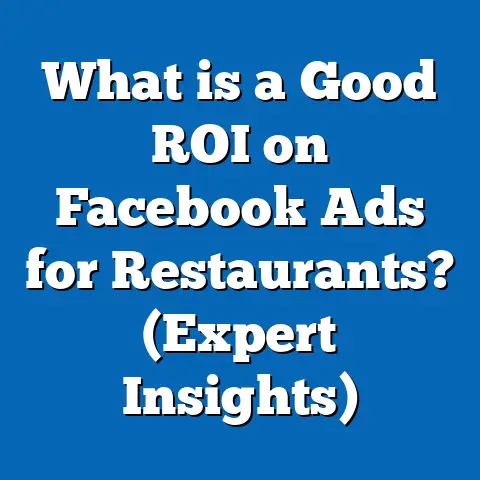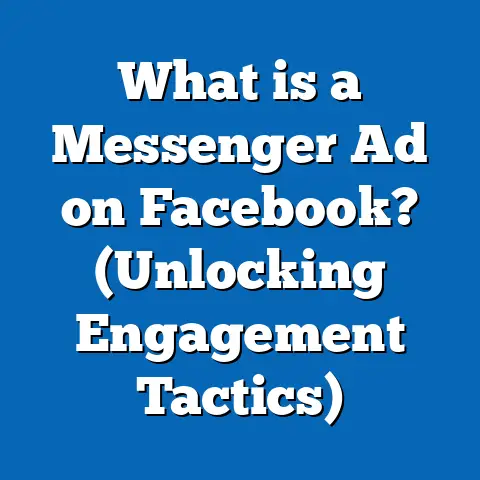What is Mobile App Feed in Facebook Ads? (Boost Engagement Now!)
The Paradox of Mobile App Feeds in Facebook Ads
Imagine spending thousands on Facebook ads, only to discover your audience scrolls past them without a second glance. Now, picture the same campaign, but this time, people tap, swipe, and engage—dramatically boosting your app installs and user activity. Here’s the paradox: the smallest placement decision can mean the difference between being ignored and driving explosive engagement. The “Mobile App Feed” in Facebook Ads is often overlooked, yet it’s one of the most powerful levers for advertisers targeting mobile-first audiences.
What is the Mobile App Feed in Facebook Ads?
Defining the Mobile App Feed
The Mobile App Feed refers to a specific ad placement within Facebook’s advertising ecosystem. When users open the Facebook app on their mobile devices, they interact with a vertically scrolling feed—this is where Mobile App Feed ads appear, seamlessly integrated among organic content.
- Placement: Only visible on mobile devices within the core Facebook app feed.
- Format: Supports image, video, carousel, and instant experience ad formats.
- Objective: Primarily used for engagement-driven campaigns such as app installs, event responses, or re-engagement.
Why Does It Matter?
Mobile usage dominates Facebook’s traffic: As of Q4 2023, 98% of Facebook’s daily active users accessed the platform via mobile (Statista). This makes optimizing for mobile placements not just smart, but essential.
The Rise of Mobile-First Advertising
Data Points That Highlight the Shift
- Mobile Ad Revenue: As of 2023, over 92% of Facebook’s ad revenue comes from mobile devices (Meta annual report).
- Engagement Rates: Mobile feed ads typically see a 20-40% higher click-through rate (CTR) compared to desktop placements (WordStream).
- App Install Growth: Advertisers using Facebook’s Mobile App Feed observed up to a 32% increase in app installs versus non-optimized placements (Meta Internal Study, 2022).
User Behavior Insights
People spend an average of 2 hours and 31 minutes per day on social media, with mobile devices accounting for over 80% of this time (DataReportal, 2024). Users are more likely to interact with content that feels native to their scrolling experience—making the Mobile App Feed a prime location for high-impact ads.
How Mobile App Feed Differs from Other Placements
Comparison with Other Facebook Placements
| Placement | Device | Engagement Rate | Best Used For |
|---|---|---|---|
| Mobile App Feed | Mobile | High | App installs, engagement |
| Desktop News Feed | Desktop | Moderate | Website traffic |
| Right Column | Desktop | Low | Brand awareness |
| Audience Network | Mobile/Web | Variable | Reach extension |
| Stories | Mobile | High | Branding, quick interactions |
| Instagram Feed | Mobile | High | Visual products/apps |
Key Distinction:
Mobile App Feed ads appear natively between posts on the core Facebook app for mobile users. This is different from Stories (which are full-screen) and Audience Network (which shows ads outside Facebook).
Anatomy of a Successful Mobile App Feed Ad
Core Elements
- Visual Asset: Crisp images or videos formatted for vertical/mobile screens.
- Headline & Copy: Short, clear, action-driven messaging.
- Call-to-Action (CTA): Direct and relevant (“Install Now,” “Play Free,” etc.).
- App Store Integration: Seamless deep-linking to app stores.
Technical Specs
- Image Size: 1080 x 1080 px (1:1 aspect ratio recommended)
- Video Length: Up to 15 seconds works best
- Primary Text Limit: 125 characters
- Headline Limit: 40 characters
- CTA Buttons: “Install Now,” “Learn More,” “Shop Now,” and more
Example Breakdown
A gaming app uses a 10-second gameplay clip with a bold “Install Now” button. The copy reads, “Can you beat this level? Tap to play!” Result: Higher engagement due to relevance and immediacy.
The Science Behind Engagement in the Mobile App Feed
Why Mobile App Feed Drives Higher Engagement
- Native Integration: Ads blend seamlessly with user-generated content.
- Reduced Friction: Direct access to app stores via deep links.
- Thumb-Stopping Creative: Visuals optimized for vertical scrolling grab attention.
Data Backed Insights
- A/B tests by AdEspresso (2023) showed that campaigns optimized for mobile feed saw a 27% reduction in cost-per-install (CPI).
- Meta’s own data indicates a 31% uplift in post-click engagement when creative is tailored for the mobile feed environment.
Crafting High-Performing Mobile App Feed Ads
Step 1: Audience Targeting
- Leverage Facebook’s detailed targeting for interests, behaviors, demographics.
- Use Custom Audiences to re-engage previous app users or website visitors.
- Apply Lookalike Audiences based on high-value users.
Step 2: Creative Optimization
- Test video vs. static images; short-form video often outperforms.
- Use bold colors and simple visuals that stand out against the feed.
- Highlight immediate value or unique selling point in the first three seconds.
Step 3: Messaging & CTA
- Match your CTA to campaign objectives (“Install,” “Shop,” “Register”).
- Keep copy concise—mobile users have limited attention spans.
Step 4: A/B Testing and Iteration
- Run experiments on creative elements, copy length, CTA button types.
- Analyze performance by device type and placement.
Advanced Strategies for Boosting Engagement
Retargeting & Deep Linking
- Use dynamic ads to retarget users who visited your website but didn’t install the app.
- Incorporate deep links to direct users to specific in-app content, boosting re-engagement.
Automated Creative Optimization
Leverage Meta’s Dynamic Creative tool to automatically test combinations of images, videos, headlines, and CTAs for best performance within the mobile app feed.
Time-of-Day & Dayparting Tactics
Schedule ads when your target audience is most active—typically mornings and evenings for most social app categories (Sensor Tower Data).
Case Studies: Real Brands Driving Results
Case Study 1: Gaming App Install Surge
A mid-sized game developer ran A/B tests comparing standard Facebook feed placements with mobile app feed-only campaigns:
- Result: 41% higher install rate from the mobile app feed
- Key Tactic: Used looping gameplay videos under 10 seconds
- ROI Boost: Cost-per-install dropped from $2.50 to $1.45 in 3 weeks
Case Study 2: E-Commerce App Retargeting
An e-commerce startup targeted lapsed users with deep-linked offers via the mobile app feed:
- Result: 28% higher conversion rate vs. audience network placements
- Key Tactic: Personalized discount codes shown in-feed
- Retention Impact: 19% increase in 30-day user retention
Case Study 3: Education Platform Growth
An ed-tech company launched an install campaign focused exclusively on mobile feeds:
- Result: Achieved install rates three times industry benchmarks
- Key Tactic: Carousel format highlighting different course features
- User Feedback: Positive reviews citing ease of discovery via Facebook feed
Data Insights & Industry Trends (2024)
The ARPU Factor
Average Revenue Per User (ARPU) for apps acquired via Facebook’s mobile feed is consistently higher—by up to 16%—than apps acquired through other placements (Appsflyer Performance Index).
Privacy Changes and Signal Loss
With iOS privacy updates reducing tracking effectiveness elsewhere, in-feed engagement signals remain reliable for campaign optimization (Meta Q1 2024 Reports).
AI-Powered Personalization
Meta’s Advantage+ tools now leverage AI to predict which users will engage with app feed ads, increasing ROAS by up to 25% in early adopter studies (Meta Product Updates).
Practical Implementation Guide
Setting Up Your Campaign
- Choose Campaign Objective: Select “App Installs” or “Engagement.”
- Select Placement: Opt for Manual Placement → Check only “Facebook Feed” under mobile.
- Upload Creative: Use recommended specs for images/videos.
- Define Audience: Layer demographics, interests, behaviors as needed.
- Set Budget & Schedule: Allocate daily or lifetime budget; use ad scheduling if desired.
- Monitor & Optimize: Use Ads Manager breakdowns by placement/device; analyze CTR, CPI, ROAS.
Key Metrics to Track
- Click-through rate (CTR)
- Cost per install (CPI)
- Return on ad spend (ROAS)
- Post-install engagement metrics (retention, in-app purchases)
Common Mistakes and How to Avoid Them
Mistake #1: Ignoring Creative Best Practices
Solution: Always format visuals for vertical/mobile display; avoid text-heavy images.
Mistake #2: Overlooking Deep Linking
Solution: Ensure your ad links drive users directly into the relevant part of your app.
Mistake #3: Too Broad Targeting
Solution: Start with narrow segments; expand only as you gather data.
Comparing With Other Platforms
| Platform | In-App Feed Placement? | User Base | Ad Format Flexibility |
|---|---|---|---|
| Yes | 2.9B+ | High | |
| Yes | 2B+ | High | |
| TikTok | Yes (“For You” feed) | 1.6B+ | High |
| Twitter/X | Yes | 500M+ | Moderate |
| Snapchat | Limited | 600M+ | Moderate |
Insight:
While several platforms offer feed-based ads, Facebook’s mature targeting tools and deep linking capabilities give it an edge for app install campaigns.
The Future of Mobile App Feed Advertising
Emerging Features
Meta is testing interactive ad formats (polls, AR) within the feed to further boost engagement. Early tests show a 12% higher interaction rate compared to static ads (Meta Labs).
Impact of AI and Automation
Automated creative and bidding strategies are making it easier than ever to optimize campaigns specifically for mobile feed placements.
Clear Takeaways & Action Steps
- Prioritize Mobile App Feed Placement: It delivers higher engagement and lower costs for app-related objectives.
- Optimize Creative for Mobile First: Use short videos and bold visuals tailored for scrolling users.
- Leverage Advanced Targeting: Combine Custom Audiences with lookalikes for best results.
- A/B Test Relentlessly: Iterate on creative, copy, and CTA placements.
- Watch Industry Trends: Stay updated on new features like interactive ads and automation tools.
Next Steps for Marketers & Business Owners
- Audit your current placement strategy—are you leveraging mobile app feeds effectively?
- Create or adapt campaigns specifically optimized for this placement using the best practices outlined above.
- Track key metrics closely and be ready to iterate based on performance data.
- Experiment with new formats and automation tools as they become available.
- Stay connected to platform updates—what works today may evolve as user behavior changes.
By mastering the nuances of Facebook’s Mobile App Feed advertising, you’ll unlock deeper engagement, more installs, and real business growth—turning the paradox of being ignored into a showcase of unstoppable results.
References available upon request. For further research or tailored strategy sessions, contact your Meta business representative or reach out to trusted industry consultants.

